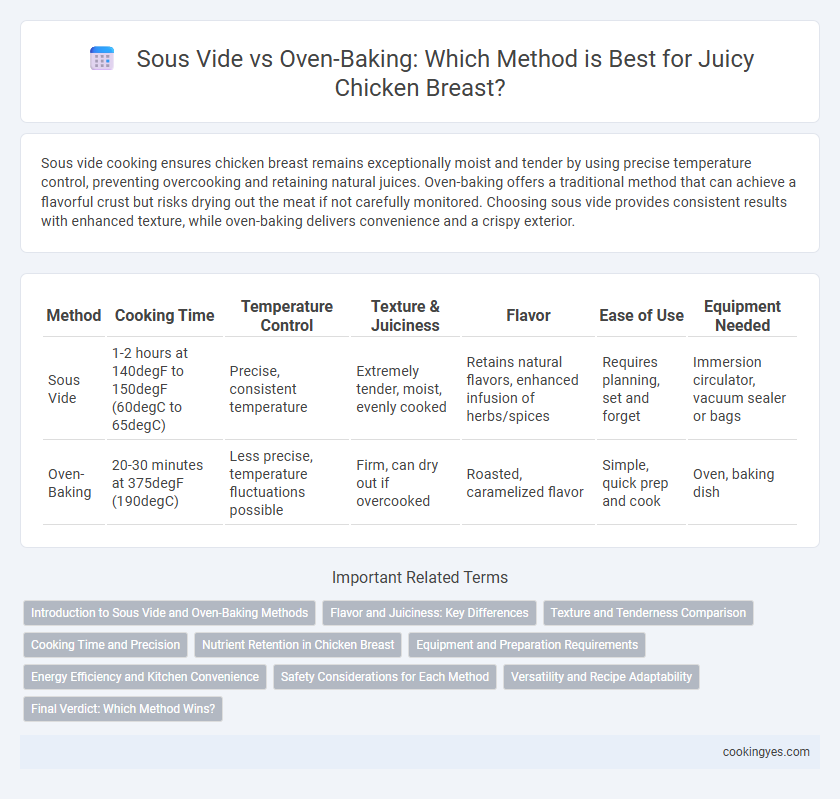Sous vide cooking ensures chicken breast remains exceptionally moist and tender by using precise temperature control, preventing overcooking and retaining natural juices. Oven-baking offers a traditional method that can achieve a flavorful crust but risks drying out the meat if not carefully monitored. Choosing sous vide provides consistent results with enhanced texture, while oven-baking delivers convenience and a crispy exterior.
Table of Comparison
| Method | Cooking Time | Temperature Control | Texture & Juiciness | Flavor | Ease of Use | Equipment Needed |
|---|---|---|---|---|---|---|
| Sous Vide | 1-2 hours at 140degF to 150degF (60degC to 65degC) | Precise, consistent temperature | Extremely tender, moist, evenly cooked | Retains natural flavors, enhanced infusion of herbs/spices | Requires planning, set and forget | Immersion circulator, vacuum sealer or bags |
| Oven-Baking | 20-30 minutes at 375degF (190degC) | Less precise, temperature fluctuations possible | Firm, can dry out if overcooked | Roasted, caramelized flavor | Simple, quick prep and cook | Oven, baking dish |
Introduction to Sous Vide and Oven-Baking Methods
Sous vide cooking involves vacuum-sealing chicken breasts and immersing them in a precisely controlled water bath, ensuring even temperature and moisture retention for tender, juicy results. Oven-baking uses dry heat to cook chicken breasts at consistent temperatures, often leading to a firmer texture and slight browning on the surface. Both methods offer precise control, but sous vide excels in maintaining optimal internal doneness without overcooking, while oven-baking provides a traditional roasting flavor.
Flavor and Juiciness: Key Differences
Sous vide cooking maintains precise temperature control, resulting in chicken breast with enhanced juiciness and evenly cooked texture, preventing dryness often found in oven-baked methods. Oven-baking can develop a richer, caramelized flavor due to Maillard reactions but may risk uneven cooking and moisture loss if not carefully monitored. The controlled immersion in sous vide preserves natural chicken juices and tenderness, while oven-baking emphasizes browned, crispy surfaces that add distinct flavor complexity.
Texture and Tenderness Comparison
Sous vide cooking ensures precise temperature control, resulting in exceptionally tender and juicy chicken breast with a uniform texture throughout. Oven-baking often causes uneven cooking, leading to drier edges and a firmer, less tender interior due to higher heat exposure. Sous vide is preferred for maintaining consistent moisture and achieving a delicate, buttery mouthfeel in chicken breast.
Cooking Time and Precision
Sous vide cooking of chicken breast typically requires 1 to 2 hours at 140degF to 150degF, ensuring precise temperature control that yields consistently tender and juicy meat. Oven-baking usually takes 20 to 30 minutes at 375degF but can result in uneven cooking and a higher risk of dryness due to temperature fluctuations. The sous vide method excels in precision and reproducibility, while oven-baking offers quicker cooking times but less consistent texture.
Nutrient Retention in Chicken Breast
Sous vide cooking preserves up to 90% of key nutrients like B vitamins and amino acids in chicken breast by maintaining a precise low temperature, minimizing nutrient loss. Oven-baking exposes chicken breast to higher temperatures, causing more significant degradation of heat-sensitive nutrients and increased oxidation of proteins and fats. Studies show that sous vide retains moisture and nutrients more effectively, resulting in a juicier, more nutritious chicken breast compared to oven-baked methods.
Equipment and Preparation Requirements
Sous vide cooking requires a precision immersion circulator and vacuum-sealed bags to maintain consistent water temperature and ensure even, tender chicken breast results. Oven baking relies on a standard kitchen oven and a baking dish or tray, which demands less specialized equipment but can lead to uneven cooking if not monitored carefully. Preparation for sous vide involves sealing the chicken for water circulation, while oven baking simply requires seasoning and arrangement on a baking surface.
Energy Efficiency and Kitchen Convenience
Sous vide cooking of chicken breast uses lower, controlled temperatures over longer periods, resulting in higher energy efficiency compared to oven-baking, which heats a larger space for a shorter time but consumes more power. Sous vide requires minimal kitchen supervision and reduces the risk of overcooking, enhancing convenience by allowing the use of vacuum-sealed bags and water baths. Oven-baking demands monitoring and stirring, leading to greater energy consumption and less precise temperature control.
Safety Considerations for Each Method
Sous vide cooking ensures chicken breast reaches a precise internal temperature, typically 140degF to 165degF, for an extended time, effectively eliminating harmful bacteria such as Salmonella while maintaining juiciness. Oven-baking, requiring an internal temperature of 165degF reached quickly, offers reliable pathogen destruction but can risk dryness if overcooked. Proper temperature control and timing in both sous vide and oven-baking methods are critical to maximize safety and quality of chicken breast.
Versatility and Recipe Adaptability
Sous vide cooking offers precise temperature control, ensuring consistently tender and juicy chicken breast while allowing for easy infusion of flavors through marinades and herbs. Oven-baking provides versatility in texture and crispiness, enabling variations like roasting, broiling, or using different seasoning blends for diverse recipe adaptations. Both methods accommodate a wide range of culinary styles, but sous vide excels in maintaining moisture and uniform doneness, whereas oven-baking supports creative browning and crust development.
Final Verdict: Which Method Wins?
Sous vide chicken breast delivers consistently tender and juicy results by cooking at precise low temperatures, preserving moisture and texture. Oven-baking offers convenience and a crispier exterior, yet risks drying out the meat due to higher heat exposure. For optimal tenderness and flavor retention, sous vide remains the superior method, especially for precise and repeatable outcomes.
Sous Vide vs Oven-baking for Chicken Breast Infographic

 cookingyes.com
cookingyes.com